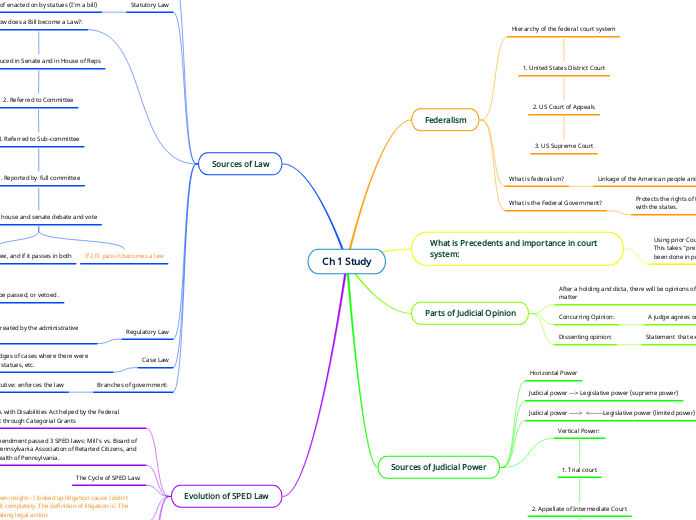Ch 1 Study
Federalism
Hierarchy of the federal court system
1. United States District Court
2. US Court of Appeals
3. US Supreme Court
What is federalism?
Linkage of the American people and communities.
What is the Federal Government?
Protects the rights of the people, while also sharing the power with the states.
What is Precedents and importance in court system:
Using prior Court cases to make a ruling on a current case. This takes "precedence" over any other ruling because it has been done in previous cases.
I looked up some information about SPED cases and precedence and came across a website full of SPED cases that showed both 1. Appeals and 2. Decisions. Here's the website: https://specialeducationlawyernj.com/special-education-law/landmark-cases-in-special-education-law/
Parts of Judicial Opinion
After a holding and dicta, there will be opinions of judicial matter
Concurring Opinion:
A judge agrees on a ruling, but not the reasoning behind it.
Dissenting opinion:
Statement that explains why the judge doesn't agree
Sources of Judicial Power
Horizontal Power
Judicial power ---> Legislative power (supreme power)
Judicial power -----> <-------Legislative power (limited power)
Vertical Power:
1. Trial court
2. Appellate of Intermediate Court
3. Court of Last Resort.
Sources of Law
Constitutional Law
Basic source of law in our legal system
Allocates responsibility among the legislative, judicial, and Executive branches of government. It defines their separation of powers.
Statutory Law
Passed of enacted on by statues (I'm a bill)
How does a Bill become a Law?:
1. introduced in Senate and in House of Reps
2. Referred to Committee
3. Referred to Sub-committee
4. Reported by full committee
5. Both house and senate debate and vote
6. Goes to Conference committee, and if it passes in both
goes to president and can be passed, or vetoed .
If 2/3 pass it becomes a law
Regulatory Law
Specific regulations for laws created by the administrative agencies.
Case Law
Published opinions of Judges of cases where there were specific regulations and statues, etc.
Branches of government:
Executive: enforces the law
Judicial Branch: creates law
Legislative: interprets the law
Evolution of SPED Law
1. individuals with Disabilities Act helped by the Federal Government through Categorial Grants
2. Every Student Succeeds Act (Statutory law).
3. Smith vs. Robinson (handicap children) supreme courts decision.
The 14th Amendment passed 3 SPED laws: Mill's vs. Board of Education, Pennsylvania Association of Retarted Citizens, and Common Wealth of Pennsylvania.
The Cycle of SPED Law:
Litigation: Own insight-- I looked up litigation cause I didn't understand it completely. The definition of litigation is: The process of taking legal action.
Following Litigation is Legislation which is: Legislation: Own insight -- I looked up Legislation to help me define, and it said, "laws considered collectively", so in a way this is similar to precedence.
The cycle continues
